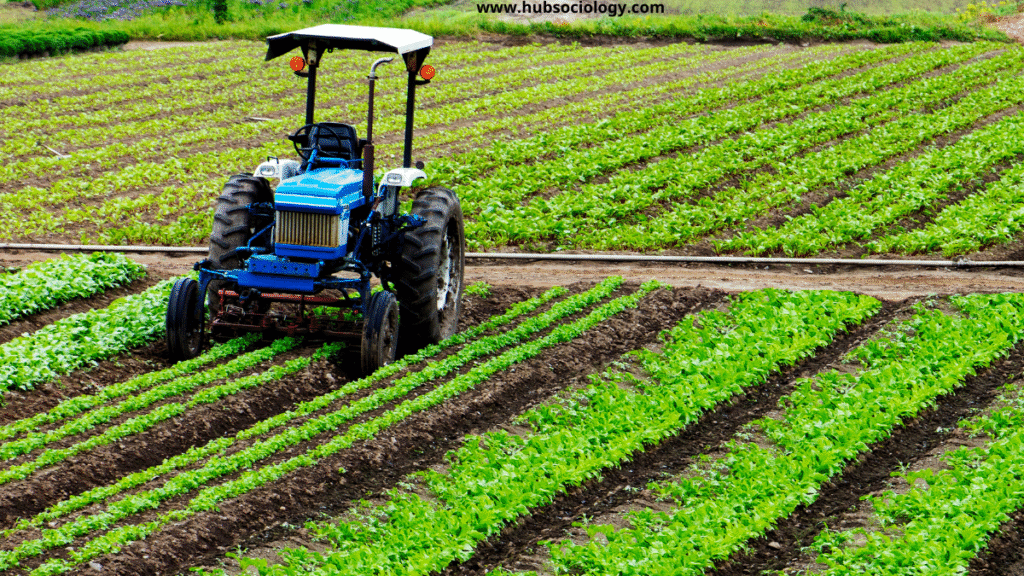Introduction
The commercialization of agriculture represents one of the most significant transformations in rural societies, particularly in the developing world. It refers to the process through which agriculture shifts from subsistence-oriented production—where farmers grow primarily for household consumption—to market-oriented production, where crops and livestock are produced mainly for sale and profit. This transformation is not merely an economic phenomenon; it is deeply sociological, reshaping social relations, class structures, gender roles, cultural values, and community life.
Understanding the commercialization of agriculture from a sociological perspective allows us to analyze how this process influences rural society—altering the nature of work, patterns of inequality, and the traditional relationship between humans and nature.

Historical Background
Commercialization of agriculture began during the colonial period in many parts of Asia, Africa, and Latin America. In India, for example, the British introduced cash crops such as indigo, cotton, tea, and jute to serve industrial demands in Europe. The colonial administration encouraged peasants to replace food crops with commercial crops, fundamentally changing the traditional agrarian economy.
After independence, modernization and the Green Revolution accelerated the commercialization process. Mechanization, chemical fertilizers, high-yield seeds, and irrigation systems transformed agriculture into a profit-oriented enterprise. This shift was often seen as a mark of development and progress. However, sociologically, it created new patterns of dependency, inequality, and social change within rural communities.
Meaning and Dimensions of Commercialization
Commercialization of agriculture involves several dimensions:
- Economic Dimension – Agriculture becomes part of the capitalist market system where production decisions are guided by profit motives and market demand rather than family needs.
- Technological Dimension – Use of modern technologies such as tractors, hybrid seeds, and irrigation leads to increased productivity but also increases dependency on capital and external inputs.
- Social Dimension – Changes in land ownership, labor relations, gender roles, and rural hierarchies emerge as farmers become integrated into the broader market economy.
- Cultural Dimension – Traditional values associated with land, nature, and community cooperation give way to individualism, competitiveness, and consumerism.
Sociologically, commercialization represents a structural transformation where the rural social system transitions from a subsistence economy to a capitalist or semi-capitalist system.
Sociological Theories and Perspectives
Several sociological theories help us interpret the impact of agricultural commercialization.
- Marxian Perspective
Karl Marx viewed the commercialization of agriculture as part of the capitalist mode of production. According to him, land and labor become commodities, and the peasantry is gradually proletarianized. The small farmer often loses control over the means of production and becomes dependent on landlords, moneylenders, or agribusiness corporations. This leads to class differentiation within the rural society—between capitalist farmers, middle peasants, and landless laborers. - Modernization Theory
Modernization theorists view commercialization as a positive step towards development. They argue that the integration of agriculture into the market economy promotes efficiency, innovation, and higher income levels. However, critics argue that this view overlooks issues of inequality and social dislocation. - Dependency Theory
From a dependency perspective, commercialization is seen as a process that ties rural producers in developing countries to global capitalist systems dominated by developed nations. Farmers produce export crops for global markets while remaining dependent on imported technology and inputs, thus reinforcing economic dependency and underdevelopment. - Ecological and Feminist Perspectives
Sociologists with ecological and feminist orientations highlight how commercialization affects environmental sustainability and gender relations. Intensive commercial farming often depletes natural resources, while women—traditionally key participants in agriculture—face marginalization as men dominate cash crop production and income control.
Impact on Rural Society
1. Class Differentiation
One of the most visible sociological consequences of commercialization is the emergence of class divisions within rural communities. Wealthier farmers with access to capital and technology benefit disproportionately, while smallholders and landless laborers often face exploitation and marginalization. This has led to a new rural bourgeoisie and a growing class of agricultural laborers dependent on seasonal or wage labor.
2. Changes in Land Ownership
Commercialization has increased the concentration of land in fewer hands. Land becomes a market commodity, and landless farmers are often displaced due to debt or inability to compete. Tenant farming, contract farming, and corporate agriculture further shift control from peasants to larger entities.
3. Labor Relations and Migration
Mechanization and commercialization reduce the demand for traditional labor while increasing seasonal or contract-based employment. This change pushes many rural workers to migrate to urban areas in search of employment, altering family structures and rural demographics.
4. Gender Relations
Commercial agriculture often sidelines women. Traditionally, women were central to food production and household farming. However, with the shift to cash crops, men tend to control income and decision-making, while women’s labor remains undervalued or invisible. This feminization of rural poverty is a key sociological outcome of commercialization.
5. Cultural and Value Changes
The introduction of market logic into agriculture transforms cultural values. Community cooperation and mutual aid are replaced by competition and individual profit-seeking. The traditional moral economy of the village—based on reciprocity and kinship—is eroded, giving rise to consumerism and material aspirations.
6. Environmental Consequences
From a sociological-ecological standpoint, commercialization has also disrupted the traditional relationship between humans and nature. Intensive farming, monocropping, and overuse of chemical fertilizers and pesticides lead to soil degradation, loss of biodiversity, and ecological imbalance. These environmental problems, in turn, have social implications such as health hazards and resource conflicts.

Commercialization and Rural Development
Advocates argue that commercialization can stimulate rural development by increasing incomes, improving infrastructure, and integrating rural economies into national and global markets. Indeed, in some regions, the introduction of commercial crops has raised living standards and created new employment opportunities.
However, sociological studies show that the benefits are unevenly distributed. Commercialization often benefits large farmers and agribusiness corporations while marginalizing small farmers and traditional communities. The result is a dualistic rural economy—one modern, capital-intensive sector coexisting with a backward, labor-intensive sector.
Thus, commercialization without accompanying social reforms—such as land redistribution, access to credit, and protection for small farmers—can intensify inequality and social exclusion.
Commercialization in Contemporary Context
In the twenty-first century, globalization and neoliberal policies have further intensified the commercialization of agriculture. Contract farming, corporate agriculture, and agribusiness supply chains connect farmers directly to multinational corporations. While this provides access to global markets, it also subjects farmers to price volatility, market manipulation, and dependency on external inputs.
In India, for instance, debates around farm laws and corporate control over agriculture reflect broader sociological concerns about autonomy, justice, and rural livelihoods. Farmers’ protests in recent years highlight the struggle between traditional agrarian structures and modern capitalist forces.
At the same time, alternative movements—such as organic farming, cooperative marketing, and sustainable agriculture—are emerging as responses to the negative consequences of commercialization. These movements seek to balance economic efficiency with social justice and environmental responsibility.
Conclusion
The commercialization of agriculture is a multifaceted process that reshapes rural societies in profound ways. From a sociological perspective, it is not just a matter of economic transformation but also a question of social relations, class formation, gender inequality, and cultural change.

While commercialization can bring prosperity and modernization, it also produces new forms of dependency, inequality, and ecological degradation. A balanced approach is therefore essential—one that promotes economic efficiency while safeguarding the interests of small farmers, women, and the environment.
Sociologically, the challenge lies in ensuring that the benefits of agricultural commercialization are equitably distributed and that rural transformation proceeds in harmony with principles of social justice and sustainability. Only then can commercialization become a true instrument of inclusive and human-centered development.
Do you like this this Article ? You Can follow as on :-
Facebook – https://www.facebook.com/hubsociology
Whatsapp Channel – https://whatsapp.com/channel/0029Vb6D8vGKWEKpJpu5QP0O
Gmail – hubsociology@gmail.com
Topic Related Question
5 Marks Questions (Short Answer Type)
- Define Commercialization of Agriculture.
- What are the main features of commercialized agriculture?
- Mention two major sociological impacts of agricultural commercialization.
- Explain the difference between subsistence and commercial agriculture.
- How did colonial rule influence the commercialization of agriculture in India?
- What role did the Green Revolution play in the commercialization of agriculture?
- Write a short note on gender inequality in commercial agriculture.
- What is the Marxian view on agricultural commercialization?
- Mention two environmental effects of commercialization of agriculture.
- What is meant by cash crops? Give two examples.
10 Marks Questions (Medium Answer Type)
- Discuss the major social and economic effects of commercialization of agriculture in rural India.
- Explain the impact of agricultural commercialization on class relations in rural society.
- How does commercialization of agriculture affect women and gender roles in rural areas?
- Examine the role of globalization and neoliberal policies in the commercialization of agriculture.
- Describe how commercialization of agriculture has changed traditional village culture and values.
- Discuss the advantages and disadvantages of commercialized farming from a sociological perspective.
- How does commercialization of agriculture lead to rural inequality?
- Explain the ecological and environmental consequences of commercial agriculture.
- Discuss the relevance of Marxian and Dependency theories in understanding agricultural commercialization.
- How has commercialization of agriculture contributed to rural–urban migration?
15 Marks Questions (Long Answer / Essay Type)
- Examine the sociological implications of the commercialization of agriculture in India.
- Analyze the impact of commercialization of agriculture on class structure, labor relations, and rural inequality.
- Critically evaluate the modernization and dependency perspectives on agricultural commercialization.
- Discuss how the commercialization of agriculture has transformed traditional agrarian society and culture.
- Explain the relationship between commercialization of agriculture, globalization, and social change in rural communities.
- Evaluate the gender and environmental dimensions of commercialization of agriculture in developing countries.
- Discuss the role of state policies and agribusiness corporations in the process of agricultural commercialization.
- “Commercialization of agriculture has created development for some and deprivation for many.” — Discuss sociologically.
- Analyze the positive and negative consequences of commercialization of agriculture in the post-Green Revolution era.
- Suggest sociological measures for making commercialization of agriculture more equitable and sustainable.
